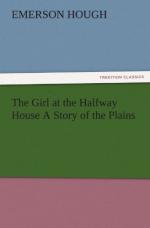But the lines of the enemy tightened ever about Louisburg. Then came a day—a fatal day—fraught with the tidings of what seemed a double death. The wife of Colonel Henry Fairfax was grande dame that day, when she buried her husband and sent away her son. There were yet traditions to support.
Henry Fairfax said good-bye to Mary Ellen upon the gallery of the old home, beneath a solemn, white-faced moon, amid the odours of the drooping honeysuckle. Had Mary Ellen’s eyes not been hid beneath the lids they might have seen a face pale and sad as her own. They sat silent, for it was no time for human speech. The hour came for parting, and he rose. His lips just lightly touched her cheek. It seemed to him he heard a faint “good-bye.” He stepped slowly down the long walk in the moonlight, and his hand was at his face. Turning at the gate for the last wrench of separation, he gazed back at a drooping form upon the gallery. Then Mrs. Beauchamp came and took Ellen’s head upon her bosom, seeing that now she was a woman, and that her sufferings had begun.
CHAPTER II
THE PLAYERS OF THE GAME
When the band major was twenty miles away in front of Louisburg his trumpets sounded always the advance. The general played the game calmly. The line of the march was to be along the main road leading into the town. With this course determined, the general massed his reserves, sent on the column of assault, halted at the edge of the wood, deployed his skirmishers, advanced them, withdrew them, retreated but advanced again, ever irresistibly sweeping the board in toward the base of Louisburg, knight meeting knight, pawn meeting pawn, each side giving and taking pieces on the red board of war.
The main intrenchments erected in the defences of Louisburg lay at right angles to the road along which came the Northern advance, and upon the side of the wood nearest to the town. Back of the trenches lay broken fields, cut up by many fences and dotted with occasional trees. In the fields both the wheat and the flowers were now trampled down, and a thousand industrious and complaining bees buzzed protest at the losing of their commerce. The defences themselves were but earthworks, though skilfully laid out. Along their front, well hidden by the forest growth, ran a line of entangling abattis of stakes and sharpened interwoven boughs.
In the centre of the line of defence lay the reserves, the boys of Louisburg, flanked on either side by regiments of veterans, the lean and black-haired Georgians and Carolinians, whose steadiness and unconcern gave comfort to more than one bursting boyish heart. The veterans had long played the game of war. They had long since said good-bye to their women. They had seen how small a thing is life, how easily and swiftly to be ended. Yellow-pale, their knees standing high in front of them as they squatted about




